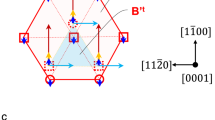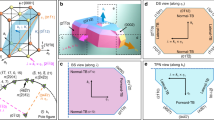Abstract
RECENTLY, with the increase of the resolving power of the electron microscope, it has become possible to make a direct observation of a crystal lattice composed of large molecules. J. W. Menter1 succeeded for the first time in observing the lattice structure and the edge dislocation contained in it in crystals of metal phthalocyanines. This method is also applicable to the study of the local variation of the fine structure in a crystal lattice, and the so-called selected area micro-diffraction method, when used jointly with this method, has proved its further usefulness.
This is a preview of subscription content, access via your institution
Access options
Subscribe to this journal
Receive 51 print issues and online access
$199.00 per year
only $3.90 per issue
Buy this article
- Purchase on Springer Link
- Instant access to full article PDF
Prices may be subject to local taxes which are calculated during checkout
Similar content being viewed by others
References
Menter, J. W., Proc. Roy. Soc., A, 236, 119 (1056).
Robertson, J. M., J. Chem. Soc., 615 (1935).
Suito, E., and Uyeda, N., Proc. Japan. Acad., 33, 398 (1957).
Author information
Authors and Affiliations
Rights and permissions
About this article
Cite this article
SUITO, E., UYEDA, N., WATANABE, H. et al. Lattice Image of Twin Structure observed directly by Electron Microscope in a Crystal of Copper Phthalocyanine. Nature 181, 332–333 (1958). https://doi.org/10.1038/181332b0
Issue Date:
DOI: https://doi.org/10.1038/181332b0
This article is cited by
-
Transformation and growth of copper-phthalocyanine crystal in organic suspension
Kolloid-Zeitschrift und Zeitschrift für Polymere (1963)
Comments
By submitting a comment you agree to abide by our Terms and Community Guidelines. If you find something abusive or that does not comply with our terms or guidelines please flag it as inappropriate.



